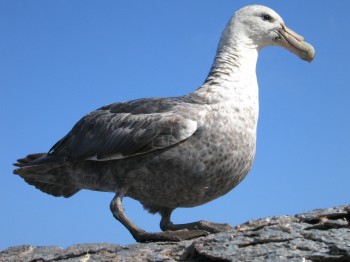Jarrod Santora (Center for Stock Assessment Research, University of California at Santa Cruz, California, USA) writes in the journal Polar Biology on top predators, including ACAP-listed giant petrels Macronectes spp., within winter pack ice off the Antarctic Peninsula.
The paper’s abstract follows:
“Global warming is predicted to reduce the amount of sea ice concentration in polar environments, thus presenting profound changes for populations of seabirds and marine mammals dependent on sea ice. Using data from a shipboard survey during August 2012, I test the hypothesis that relative abundance of seabird and marine mammals reflects environmental variability associated with the dynamic pack ice zone. Using environmental data and observations of sea ice concentration, I quantified an environmental gradient that describes the spatial organization of the dynamic pack ice zone. The relationship of top predators to this environmental gradient revealed three important aspects: (1) an open water and pack ice community is present with some top predator species exhibiting higher abundance associated with moderate sea ice concentration (40–60 %) as opposed to the pack ice edge (10 %), (2) Antarctic fur seals (Arctocephalus gazella) were the most abundant pinniped and they were observed resting on ice floes and foraging within leads and polynyas, and (3) for the most abundant species, spatial regression models indicate that latitude and sea ice concentration (a principal north/south gradient) are the most important environmental determinants. Winter ocean conditions may strongly influence population dynamics of top predators; therefore, information regarding their habitat use during winter is needed for understanding ecosystem dynamics."

A Southern Giant Petrel in Antarctica, photograph by Michael Dunn
Click here to read of a related paper by the same author.
Reference:
Santora, J.A. 2014. Environmental determinants of top predator distribution within the dynamic winter pack ice zone of the northern Antarctic Peninsula. Polar Biology DOI .
John Cooper, ACAP Information Officer, 14 July 2014

 English
English  Français
Français  Español
Español